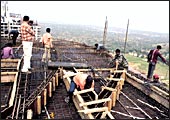 |
|
Careful, men at work: Any slip-up in execution by
developers could prove fatal
|
As
domestic real estate developers, listed and unlisted, subject
themselves to the discipline desired by their investors, their
plans and delivery schedules are going to come under harsh scrutiny.
And, why not? They are ramping up like never before. "Over
the next two years, many of them will have to deliver what they
have not done cumulatively over the past 10 years. Many of them
are banking on steep rates of land acquisition and its conversion
to developments going forward," says Kishore Gotety, Director,
Real Estate Investments, ICICI Ventures.
Any serious slip-up can derail the shining
real estate story. Chances of slip-ups are many. Over the past
two boom years, nationwide, the size and scale of real estate
projects has gone up substantially. Rapid ramp-up is putting severe
strain on the resources available to the sector. "Availability
of raw materials and quality of manpower is a challenge across
the industry," says Pranav Ansal of Ansal Properties and
Infrastructure, adding that the smaller players in the industry
are getting affected more than the larger ones, who have economies
of scale.
Perhaps one of the most difficult impediments
to overcome is the shortage of human resources. There is a painful
dearth of trained architects, designers, planners, project managers,
engineers, contractors, skilled and semi-skilled labour in the
industry currently. "And it is a shortage that is likely
to continue for another few years," says Dhiraj Singh, Country
Head, Laing O'Rourke (LOR). Such is the grim shortage in the industry
that UK-based LOR is planning to set up a training institute in
Delhi for assured supply of quality manpower. Earlier this year,
LOR had formed a joint venture to execute DLF's new projects.
With this JV, which has nearly 1,000 people on its rolls, DLF
has tried to ensure a reliable delivery partner for its ambitious
plans. Other developers such as Unitech outsource their construction.
Here again, the smaller developers are hit worse.
Another crucial factor will be the availability
of capital. RBI regulations like stricter provisioning and increased
risk weightage norms on commercial real estate, has increased
the cost of property financing. "Interest cost for developer
funding has gone up by 300-400 basis points over the last one
year," says Mumbai-based Akruti Nirman's Vimal Shah. More
importantly, RBI has also come down heavily on funding land acquisition,
arresting the self-feeding capital cycle. And not many developers
have ready cash to fund more acquisitions, or even their present
commitments if customer confidence in the builder declines. Says
Unitech's MD, Sanjay Chandra: "Many developers do not realise
what it takes to deliver. Every one of them has sold, but how
many of them have put a brick to the land? It is shocking. That
is the scary part about the market. Today, everyone wants to be
a developer."
 |
|
The flip side: Small players are more likely to
be affected by labour crunch
|
Well, it won't be for long. In this over-arching
environment of scarcity, execution will not only be the key risk,
but it will also be the main differentiator, separating the men
from the boys ruthlessly. Going forward, developers would need
to become specialised and systematic as quality gets a premium.
"As land prices escalate and margins decline, developers
will have to provide value addition," says Shah of Akruti,
which is building a mechanised car park in its new residential
building.
The smarter developers are already planning
to raise equity to finance future growth. But the absence of a
clear professionally-run corporate structure could sharpen capital
constraints. At present, most of them are single-city or regional
builders, typically family-owned businesses run by one person,
with single-asset types of development. It will be difficult to
transition from that level. Some developers may well sell out
to bigger developers. That process has already begun. "We
have already received some offers from developers who have not
been able to deliver," says Ansal. "They had problems
with costing, accounting, were not able to accumulate land and
did not get the right kind of people-architects and contractors.
Another year or two down the line, more such cases will crop up,"
he believes.
This kind of consolidation may well decide
the industry structure a few years hence-some 8-10 dominant large,
pan-Indian developers and a second tier of numerous developers
could still continue to thrive. Given the local nature of the
business, the one-project developers will continue to thrive.
"Larger projects will allow the large developers to grow
faster than the industry," says an optimistic Chandra. So,
pick your builder with care.
|






